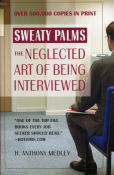| What REALLY goes on in a job interview? Find out in the new revision of "Sweaty Palms: The Neglected Art of Being Interviewed" by Tony Medley, updated for the world of the Internet . Over 500,000 copies in print and the only book on the job interview written by an experienced interviewer, one who has conducted thousands of interviews. This is the truth, not the ivory tower speculations of those who write but have no actual experience. "One of the top five books every job seeker should read," says Hotjobs.com. Click the book to order. Now also available on Kindle. | |
|
Nightcrawler (9/10) by Tony Medley Runtime 117 minutes OK for children. Jake Gyllenhaal gives a tour de force as an unscrupulous “stringer” cameraman shooting violent nighttime news events in Los Angeles. Although it lasts almost two hours, it’s tightly written and directed by Dan Gilroy. I’m generally hard on movies that run longer than 90 minutes but I didn’t see anything that could have been cut. It is a faithful production of Los Angeles TV news. The realism is even more profound because it was shot on location at KTLA, Channel 5 in Los Angeles, which is LA’s most iconic TV station. KTLA was the first commercially licensed TV station in the West (1947), and was the home of people like Daws Butler and Stan Freberg who were the principal actors in Time for Beany that started in 1949 (it was one of Albert Einstein’s favorite shows, and mine, too) on KTLA. If any station is loved by longtime Angelenos, it is KTLA, which was owned by Gene Autry from 1963-82 (Gene bought KTLA and radio station KMPC for $12 million and sold them for $245 million). Lou Bloom (Gyllenhaal) is a sneak thief who by chance falls into filming late night violence and selling his videos to local TV stations as an independent stringer. He meets Nina (Rene Russo), the 50-ish News Director at KWLA, who recognizes his “talent,” and jumps at the chance to use his graphic footage to raise KWLA’s ratings. While Nina is a caricature, not unlike Faye Dunaway’s character who exploited Peter Finch’s “Mad as hell” character in 1976’s Network, she’s not quite as over the top as Faye, and is, therefore, a little more believable. As the movie progresses, however, the relationship between Lou and Nina develops to where there’s a question as to who is exploiting whom. Lou hires an “apprentice,” Rick (Riz Ahmed), whom he shamelessly manipulates. The progress of the film is exemplified by the car Lou drives. In the first part of the film when he’s starting out, he drives a blue Toyota Tercel and uses a basic hi def video camera. Then, when he gets successful, he suddenly appears in a red Challenger with a professional camera with a good microphone. Another exceptional part of the movie is the car driving. Lou drives fast and scares the wits out of Rick. At the climax, there’s a chase through the streets of Los Angeles that, while relatively preposterous, is so well filmed that it elicits memories of the classic car chase in Bullitt (1968). The terrific script is buttressed by atmospheric cinematography (Robert Elswit) and tension-enhancing music (James Newton Howard). It is also an homage to Los Angeles as there were approximately 75 different locations used during the filming. October 21, 2014
|
|
|
|
|
